
Chapter 1. Chapter 12: Complex Inheritance
1.1 Introduction

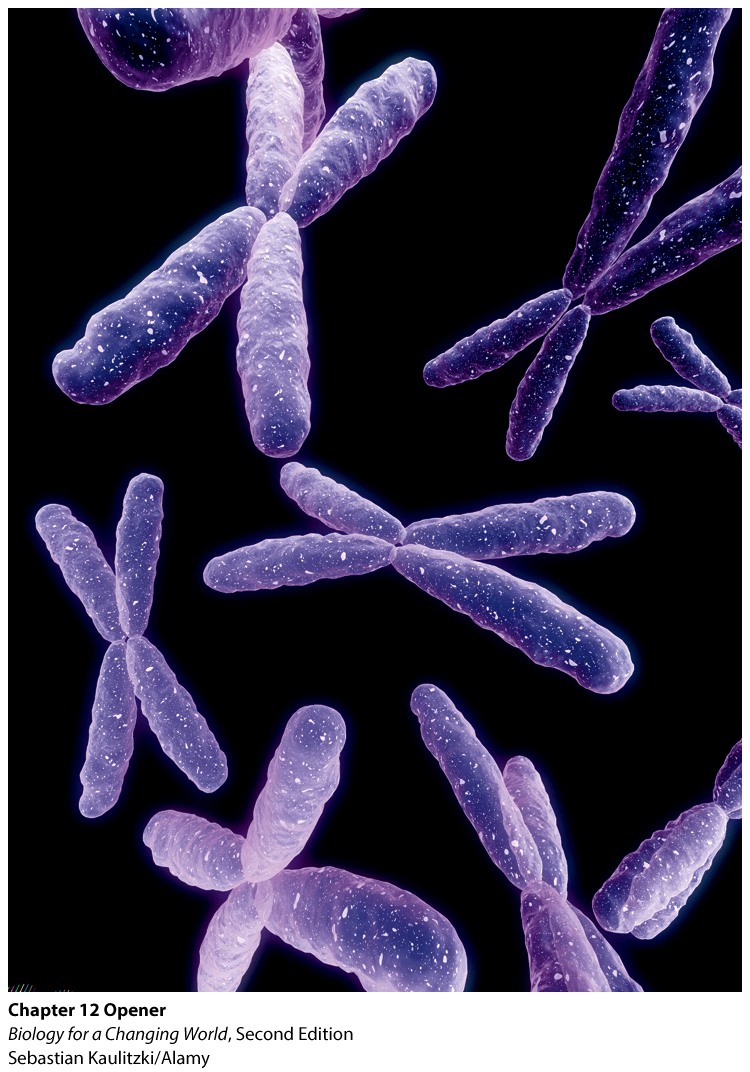
Welcome to the Interactive Study Guide for Chapter 12: Complex Inheritance! This Study Guide will help you master your understanding of the chapter's Driving Questions, using interactive Infographics and activities, as well as targeted assessment questions. Click "Next" to get started, or select a Driving Question from the drop-down menu to the right.
Genetics Q&A:
Complexities of human genetics, from sex to depression
DRIVING QUESTIONS
- How do chromosomes determine sex and how does sex influence the inheritance of certain traits?
- Some traits are not inherited in simple dominant or recessive inheritance patterns. What are some complex inheritance patterns?
- How do numerical abnormalities of chromosomes occur and what are the consequences of these abnormalities?
1.2 Driving Question 1
Driving Question 1
How do chromosomes determine sex, and how does sex influence the inheritance of certain traits?
Why should you care?
Gender identity is an essential part of a person's sense of self and is determined by the sex chromosomes that a person inherits. Although there are 22 pairs of 'non-sex' chromosomes, or autosomes, and only one pair of sex chromosomes in human cells, the special properties of the X and Y sex chromosomes make them important to people's lives for a several reasons: those with two X chromosomes in their cells are usually female, and those with an X and a Y chromosome are usually male. Furthermore, many human traits—including some diseases—are sex linked, usually meaning that they tend to be more prevalent in males than females. And recently, scientists have been able to make use of the lack of recombination between X and Y to trace paternity and family trees through Y chromosome sequences.
There is only one pair of sex chromosomes in the human genome, and they differ from the rest of the pairs in that they are not all the same size and do not carry all the same genes. The X chromosome is the larger of the two human sex chromosomes and therefore carries more genes, most of which are not related to sex determination. The traits controlled by these genes on the X chromosome are called X-linked traits. The Y chromosome is shorter than the X and carries many fewer genes, but it does carry the genes responsible for creating the developmental changes that make a child male. (The names X and Y for these chromosomes are historical and have nothing to do with their shape—a common misconception.)
An X-linked trait like Duchenne Muscular Dystrophy, usually involves an allele that is recessive. Women who have a functional allele on their other X chromosome can still make enough of the functional protein to make up for the disease allele. Men who inherit the DMD allele, however, only have the defective allele on their single X chromosome, and will therefore have the disease.
The X chromosome has many genes that the Y chromosome does not. Because of this, the X and Y chromosomes do not usually recombine (exchange genetic material) during meiosis, and Y chromosomes change less from generation to generation than X chromosomes. This makes the Y chromosome useful in geneological studies and paternity testing.
What should you know?
To fully answer this Driving Question, you should be able to:
- Explain how sex is determined in human children.
- Describe the location and importance of the SRY gene.
- Differentiate between the main sex hormones.
- Diagram how X-linked traits are inherited and predict the chance that a child will have an X-linked trait based on the parents’ genotype.
- Diagram a human pedigree, following symbol conventions, and use it to track the inheritance of diseases.
- Explain the difficulties in predicting whether a female child will be a carrier of an X-linked trait based on phenotype alone.
- Explain why the Y chromosome does not often/usually undergo recombination with the X chromosome, and why this fact is important.
- Explain why STR locations on the Y chromosome are useful for paternity and identity tests.
Infographic Focus:
The infographics most pertinent to the Driving Question are 12.1, 12.2, 12.3, 12.4 and 12.5.
Test Your Vocabulary
Choose the correct term for each of the following definitions:
| Term | Definition |
|---|---|
| A phenotype determined by an allele on an X chromosome. | |
| Paired chromosomes present in both males and females; all chromosomes except the X and Y chromosomes. | |
| Sex organs; ovaries in females, testes in males. | |
| Comparing sequences on the Y chromosome to examine paternity and paternal ancestry. | |
| Paired chromosomes that differ between males and females, XX in females, XY in males. | |
| A visual representation of the occurrence of phenotypes across generations. |
Explain how sex is determined in human children.
1.
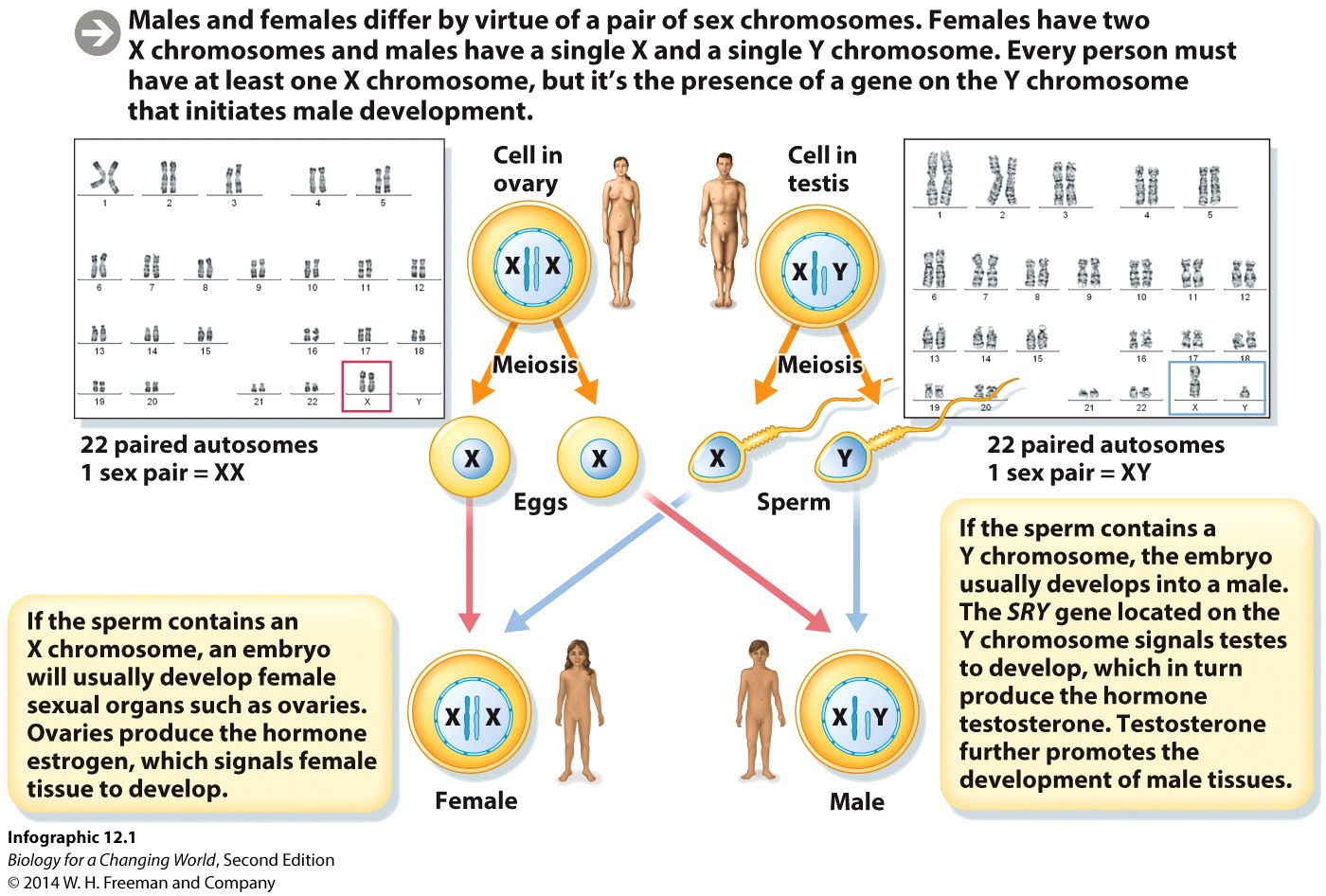
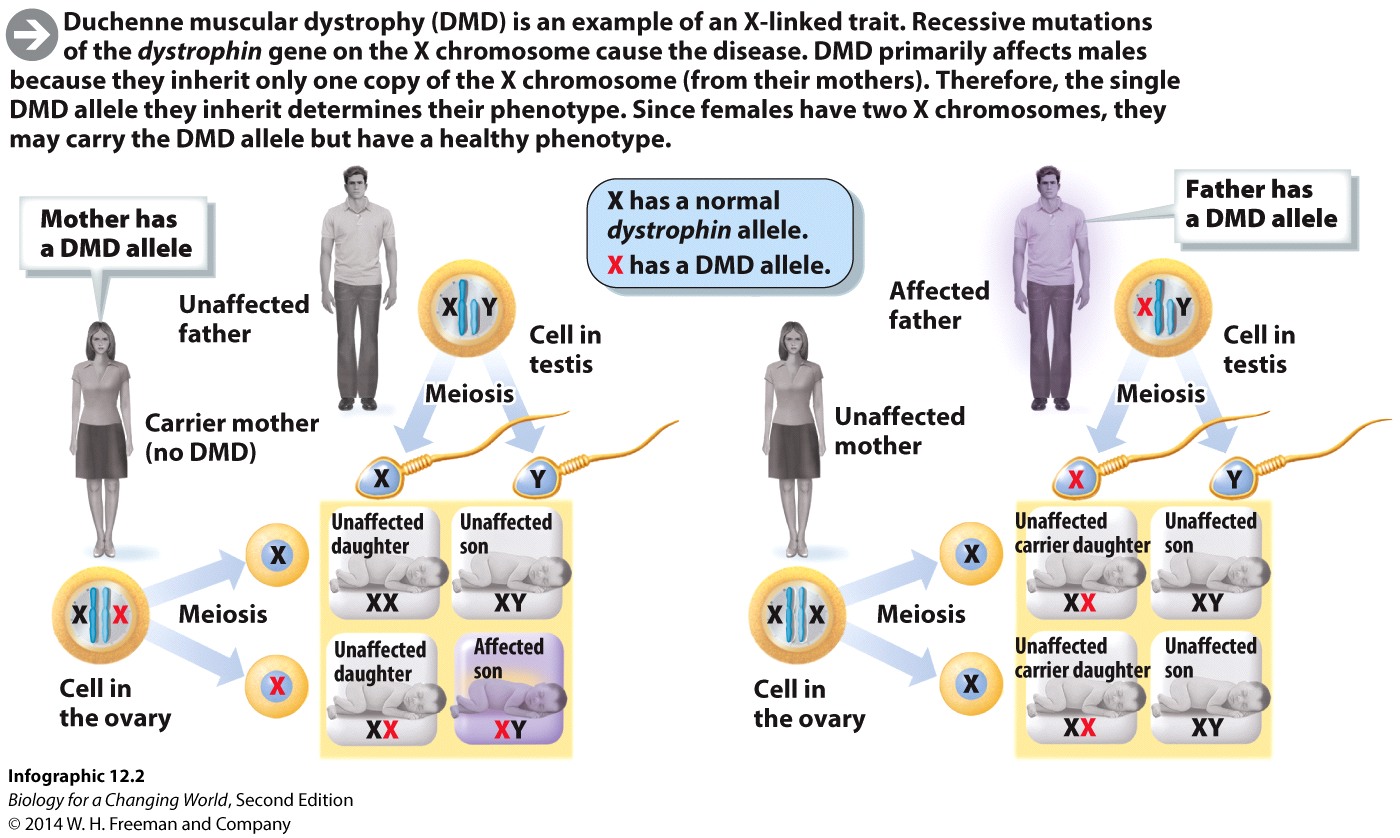
Examine Infographics 12.1 and 12.2. Draw a Punnett Square. In other words, cross an XX woman with an XY man.
| X | Y | |
| X | XX | XY |
| X | XX | XY |
2.
How many kinds of eggs can a woman produce in terms of their sex chromosomes?
3.
How many kinds of eggs can a woman produce in terms of their sex chromosomes?
4.
In any given fertilization event, what is the chance that a child will be XX? XY?
5.
In any given fertilization event, what is the chance that a child will be male? Female?
Describe the location and importance of the SRY gene.
6.
SRY controls many other genes that determine biological maleness. Is it more likely to be found on the X, Y, or both chromosomes? Why?
7.
Since the SRY gene is on the Y chromosome, predict the genotype and outward appearance of children with a mutation in the SRY gene that results in a nonfunctional SRY protein.
Differentiate between the main sex hormones.
8.
Compare and contrast the effects of two important sex hormones, estrogen and testosterone.
Diagram how X-linked traits are inherited and predict the chance that a child will have an X-linked trait based on the parents’ genotype.
9.
A gene that controls the ability to see red and green is located on the X chromosome but not on the Y chromosome. There is a recessive nonfunctional allele for this gene that can cause red-green color blindness if the person possessing it does not also have the dominant normal gene. Consider the case of a carrier mother who is heterozygous for the red-green vision gene and a father who has normal vision.
Make a Punnett Square based on these parents (i.e. cross the X*X mother with the XY father).
X*: has red-green colorblindness genotype and phenotype
| X | Y | |
| X | XX | XY |
| X* | XX* | X*Y |
10.
What is the chance the parents would have a color-blind boy?
11.
A color-blind girl?
12.
What about a girl or boy with normal vision?
13.
Redo the Punnett Square for a carrier mother (X*X) and a color-blind father (X*Y).
X* = has red-green colorblindness genotype and phenotype
| X* | Y | |
| X | XX* | XY |
| X* | X*X* | X*Y |
14.
Do the chances for having color-blind children change? How?
15.
Refer to your previous answer and explain, using either a diagram or words, how being a carrier for a sex-linked trait works. In other words, how does a woman who does not exhibit a sex-linked trait pass that trait on to her child?
16.
Why are male children more likely to exhibit sex-linked traits than female children?
Diagram a human pedigree, following symbol conventions, and use it to track the inheritance of diseases.
17.
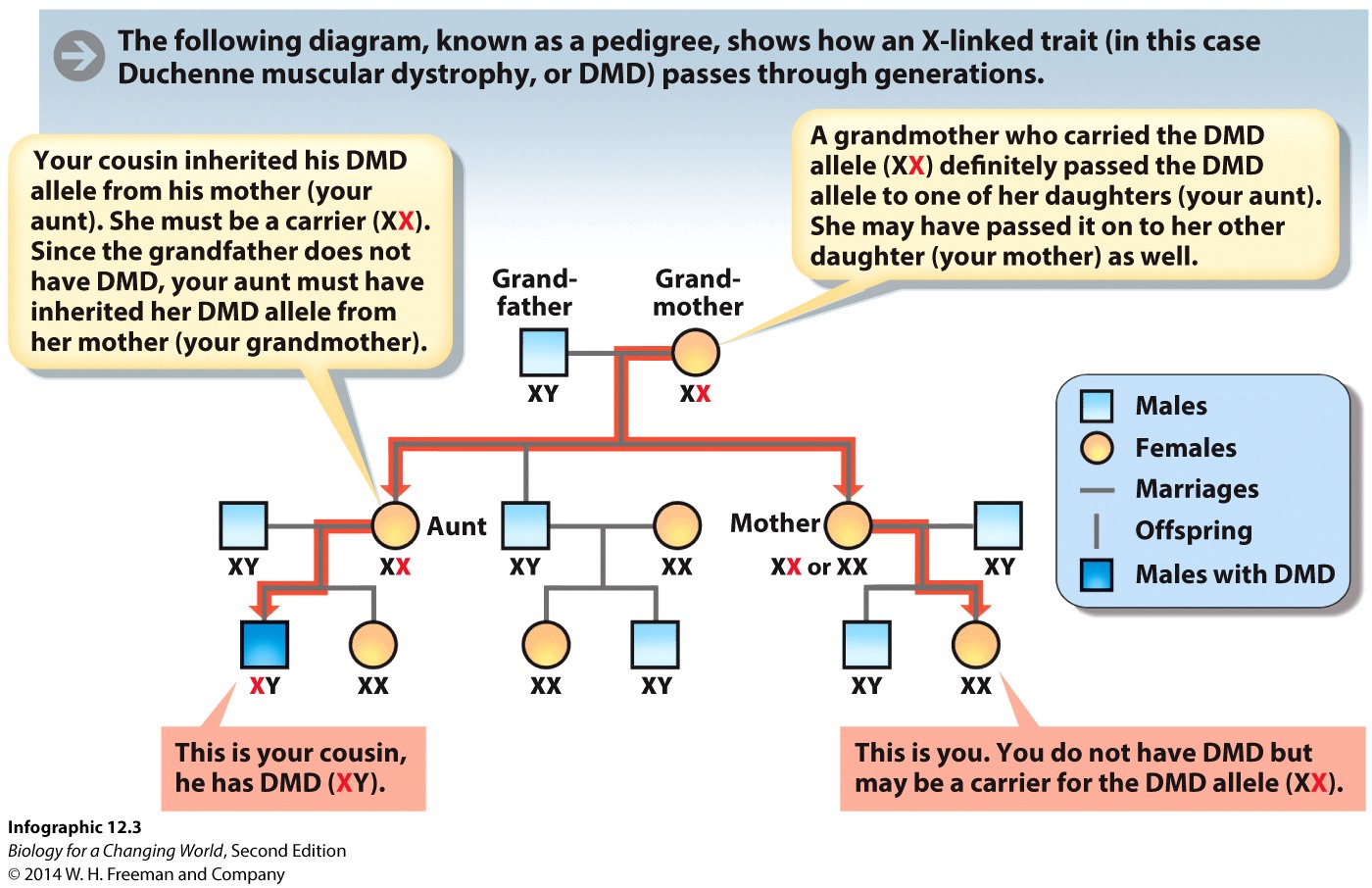
Examine the formatting of the pedigree chart in Infographic 12.3 so that you will be able to make your own.
Assume that you have red-green color blindness. Based on your own gender and what you know about the inheritance, determine whether you inherited this condition from a maternal grandparent, paternal grandparent, or one of each.
18.
Draw up a pedigree of your own family that illustrates how you could have inherited color blindness. (You do not have to be exact about the number of relatives.)
19.
Would any of your parents or grandparents also have had to be color-blind?
Explain the difficulties in predicting whether a female child will carry an X-linked trait based on phenotype alone.
20.

Examine your pedigree and the one in Infographic 12.3. Why is it possible for multiple generations of women to carry a recessive disease and be unaware of it?
Explain why the Y chromosome does not often or usually undergo recombination with the X chromosome, and why this fact is important.
21.
Consider the following facts:
Homologous chromosomes must have similar sequences to recombine.
Recombination is always a rare event, but the recombination of genes between the X and Y chromosomes is rarer still, although it does occur.
It is thought that the X and Y chromosomes were once completely homologous in the earliest mammals.
Explain why the X and Y chromosomes for the most part do not recombine and why this is important.
Explain why STR locations on the Y chromosome are useful for paternity and identity tests.
22.
If STR locations are found on every chromosome, why are STR locations on the Y chromosome useful for paternity testing? What have you already learned that explains why the Y chromosome is ideal for tracking ancestry?
Review Questions
23.
For Questions 23 and 24, use the following information: Type A Hemophilia, a disorder in which blood does not clot properly, is governed by a recessive allele on the X chromosome. Suppose a healthy woman marries a man with Hemophilia A, and they are expecting a child.
What is the chance the child will be male?
| A. |
| B. |
| C. |
| D. |
| E. |
24.
What is the chance the child will be a male with hemophilia?
| A. |
| B. |
| C. |
| D. |
| E. |
25.
How many homologous pairs of chromosomes should the average human male have in his somatic (nongamete) cells?
| A. |
| B. |
| C. |
| D. |
| E. |
26.
For researching ancestry, human pedigrees have the advantage of ____________, while STR analyses of the Y chromosome have the advantage of ____________.
| A. |
| B. |
| C. |
| D. |
| E. |
1.3 Driving Question 2
Driving Question 2
Some traits are not inherited in simple dominant or recessive inheritance patterns. What are some complex inheritance patterns?
Why should you care?
The inheritance of many traits involves more than one gene or may not be governed by alleles that show a simple dominant-recessive pattern. Moreover, many traits are influenced by environmental factors as well as genes. It is tempting to be disappointed to find out that predicting the inheritance of seemingly simple traits like eye color or height is far from straightforward. But rather than a disappointment, it can be exciting to learn that we are all more than the sum of our genes.
If you recall that genes are actually the building plans for the construction of proteins, and that alleles are different versions of genes, then the concept of codominance will make a lot of sense. When two alleles are codominant, they are both expressed at the same time. In the case of ABO blood types, two alleles (A and B) are codominant, and a third (O) is recessive. This means that if alleles A and B are both present in a person's genotype, the person's blood type wil be based on both the A and B blood-type proteins. In other words, the person will have type AB blood. Understanding codominance will help you understand blood types, which is an important health concept, and it will help you understand the inheritance of other traits.
Besides the many genes involved in brain development and function, your nutrition, education and experiences also influence the way your brain works. In other words, personality and mental health are polygenic and multifactorial traits, just like height.
What should you know?
To fully answer this Driving Question, you should be able to:
- Predict the potential trait (phenotype) that will be exhibited by a child for a gene whose alleles exhibit incomplete dominance.
- Describe the differences in blood markers between the different blood types.
- Predict a person’s genotype for the ABO blood type gene based on the person’s blood type.
- Compare and contrast complete dominance, incomplete dominance, and codominance.
- Differentiate between polygenic and multifactorial inheritance.
- Propose an explanation for how multifactorial inheritance works in the case of the serotonin transporter allele, stressful life events, and incidence of depression.
Infographic Focus:
The infographics most pertinent to the Driving Question are 12.6, 12.7, 12.8, 12.9, 12.10 and 12.11.
Test Your Vocabulary
Choose the correct term for each of the following definitions:
| Term | Definition |
|---|---|
| An interaction between genes and the environment that contributes to a phenotype or trait. | |
| A form of inheritance in which both alleles contribute equally to the phenotype. | |
| A form of inheritance in which heterozygotes have a phenotype that is intermediate between homozygous dominant and homozygous recessive. | |
| Variation in a population showing an unbroken range of phenotypes rather than discrete categories. | |
| A trait whose phenotype is determined by the interaction among alleles of more than one gene. |
Predict the potential trait (phenotype) that will be exhibited by a child for a gene whose alleles exhibit incomplete dominance.
27.
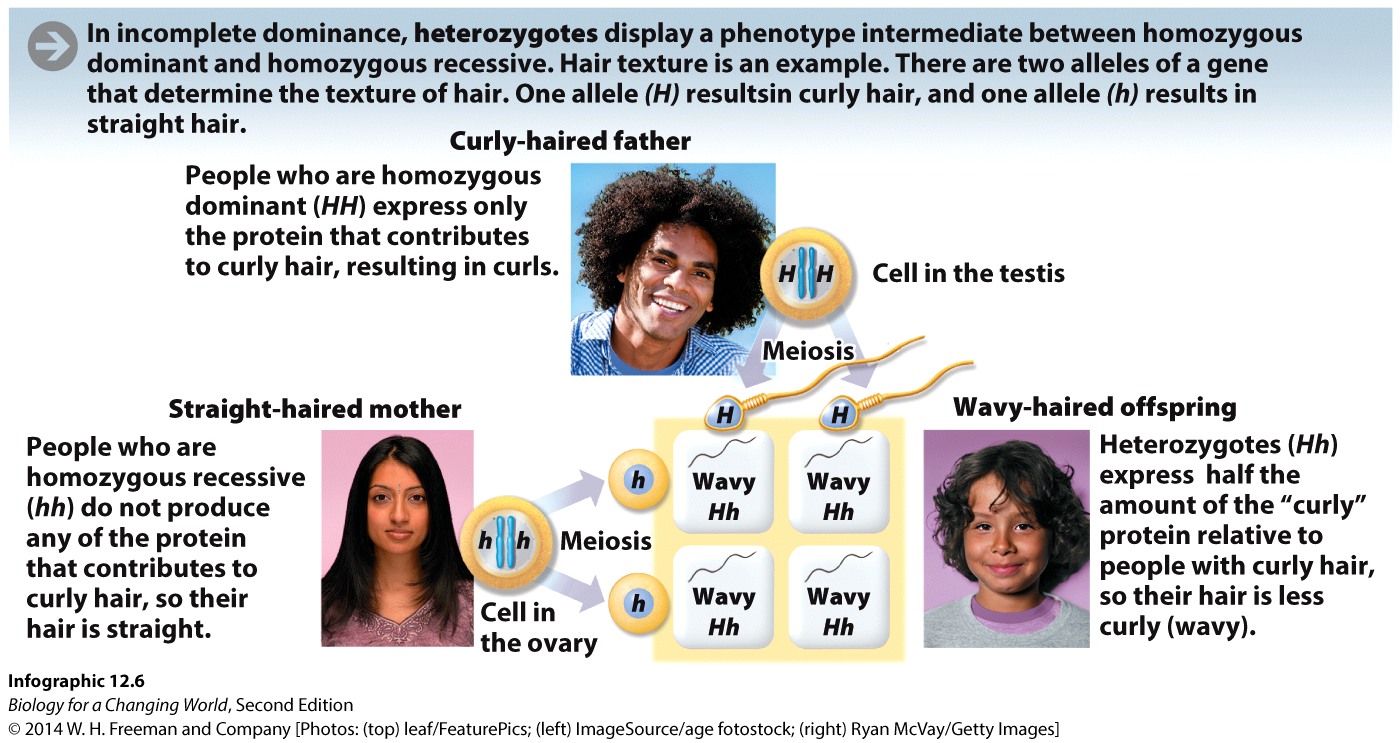
Hair texture exhibits incomplete dominance in humans, and the alleles involved are shown in Infographic 12.6. Is it possible for two parents with wavy hair to have a curly-haired child? Fill in the Punnett square that follows to answer the question.
- Determine the alleles that the mother and father should have and write the genotype of the testis and ovary cells.
- Enter the correct allele in the eggs and sperm cells made by the parents.
- Combine the eggs and sperm cells in all possible ways using the Punnett square.
- Make sure to write both the genotype (allele combination) and the phenotype (type of hair texture) that would result in the zygotes produced from each fertilization event of the Punnett square.
28.
What is the chance that two wavy-haired parents will have a wavy-haired child?
Deduce a person’s genotype for the ABO blood type gene based on the blood types of the person’s family members.
29.
What are the three ABO blood type alleles?
, , and
30.
Which of the above allele(s) are codominant?
31.
Using pedigrees, Punnett Squares or both, determine Person X’s ABO blood type genotype based on the three facts that follow:
Person X has phenotypic type B blood:
32.
Person X has a parent with phenotypic type A blood.
33.
Person X has a child with phenotypic type O blood.
Compare and contrast complete dominance, incomplete dominance, and codominance.
34.
Explain how the three patterns of inheriting a trait (complete dominance, incomplete dominance, and codominance) can all be explained by the fact that genes are the blueprints for building proteins. Use Huntington disease, hair texture, and ABO blood groups as examples.
In the case of hair texture, an incomplete dominance trait, both alleles (C, curly and c, straight) produce functional proteins. The result is an intermediate phenotype of not quite curly but not quite straight hair, or wavy hair. If a trait is classified as incomplete dominant, neither allele product (protein) is fully dominant over the other, but one protein typically has a greater effect on phenotype than the other.
For traits that are codominant, like blood type (A, B, and O), the proteins produced by alleles A and B, for example, contribute equally to the phenotype of the organism. In this case, the red blood cell would have both A and B markers on the cell surface. Neither allele is dominant over the other.
Differentiate between polygenic and multifactorial inheritance.
35.
Does height in humans exhibit a few discrete phenotypes, or does it show continuous variation? What is the main reason for this? Besides genetics, which factors influence height in humans?
36.
Compare and contrast polygenic with multifactorial inheritance.
37.
Explain why it is difficult to predict the height of a child based on the height of the child’s parents.
Explain how multifactorial inheritance works in the case of the serotonin transporter allele, stressful life events, and incidence of depression.
38.
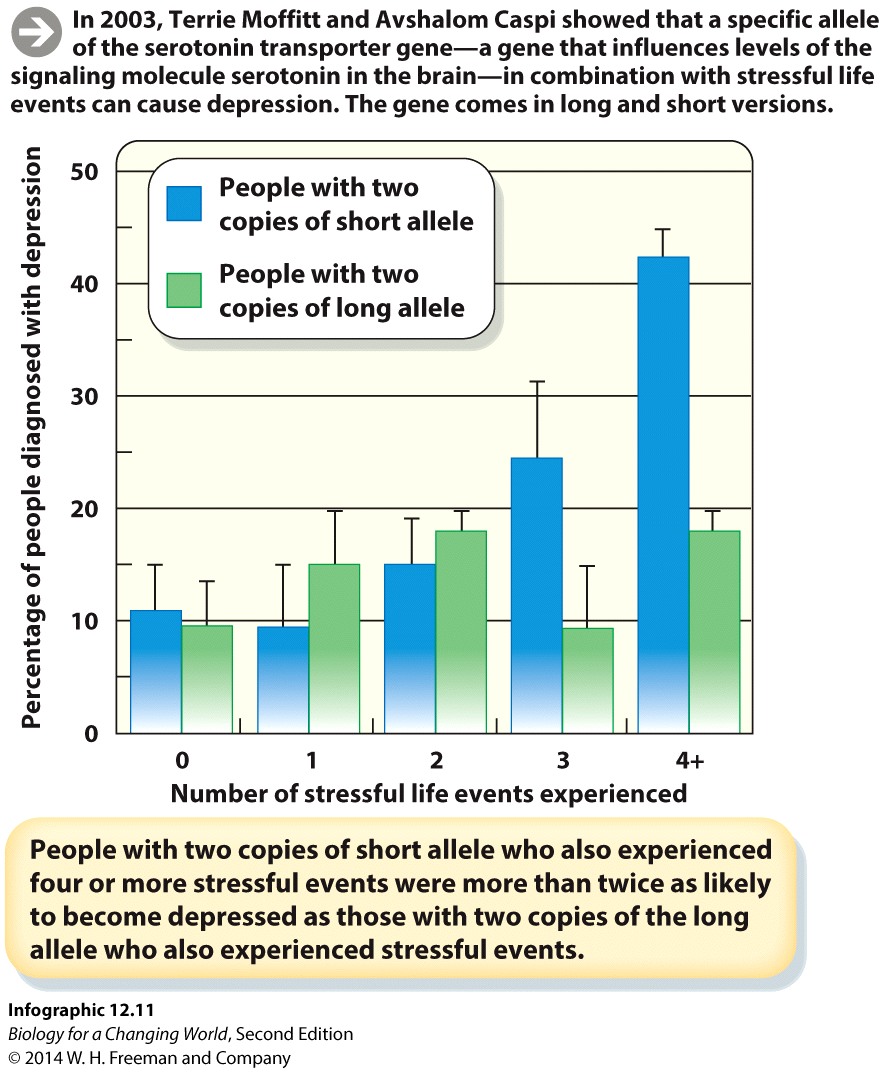
Examine the chart in Infographic 12.11, comparing the paired bars as you scan across it left to right. For a person with two copies of the short allele, what seems to be the tipping point in terms of number of past stressful events? In other words, at what point does there seem to be a much higher chance that one more stressful event will lead to depression? What about a person with two copies of the long allele? How many stressful events does it take to lead to a higher chance that one more stressful event will lead to depression?
39.
What influence does being homozygous for the short allele for the serotonin transporter have on depression?
40.
How would you explain the fact that some people who have the long allele for the serotonin transporter also develop depression?
Review Questions
41.
If a curly-haired man and a wavy-haired woman have a child, what is the chance the child will have straight hair?
| A. |
| B. |
| C. |
| D. |
| E. |
42.
You are investigating a paternity claim. You have the following information for the child and the candidate father: eye color, blood type, and height. Which would you use as a starting point for your investigation?
| A. |
| B. |
| C. |
43.
The only variable that contributes to a person’s phenotype is genotype.
| A. |
| B. |
44.
Can a particular trait be both polygenic and multifactorial?
| A. |
| B. |
1.4 Driving Question 3
Driving Question 3
How do numerical abnormalities of chromosomes occur, and what are the consequences of these abnormalities?
Why should you care?
Some genetic disorders are not the result of problems with single genes but with entire chromosomes. We have already looked at some chromosomal defects involving sex chromosomes such as Turner Syndrome (X0) and Klinefelter's Syndrome (XXY); both are examples of aneuploidy, which means not having the proper number of one or more particular chromosome. Aneuploidy of autosomes can also occurs, and it almost always has negative impacts. (The effects of the common sex chromosome aneuploidies are not as serious as those of autosomal aneuploidy because the Y chromosome has very few genes, and because all X chromosomes except one are usually inactivated in the cells of developing human embryos).
Most aneuploidies occur because of mistakes during meiotic cell division called nondisjunctions, in which chromosomes are not evenly separated and thus the resulting gametes have either additional or missing chromosomes. Most cases of autosomal aneuploidy result in spontaneous abortion or miscarriage of the affected embryos. The few non-terminal autosomal aneuploidies are always associated with birth defect syndromes (an association of common symptoms). The most well-known autosomal aneuploidy syndrome is Down Syndrome, which results from inhertiting an extra chromosome 21, a condition called trisomy 21.
What should you know?
To fully answer this Driving Question, you should be able to:
- Diagram how the chromosome number in gametes will be affected based on whether nondisjunction occurs during meiosis I or meiosis II.
- Predict the chromosomal makeup of a zygote if one of the gametes that produced it were aneuploid.
- Explain how constructing a karyotype of a fetus can determine if there is any incidence of aneuploidy, specifically how examining a fetal karyotype can determine if the child will have Down syndrome.
Infographic Focus:
The infographics most pertinent to the Driving Question are 12.12 and 12.13.
Test Your Vocabulary
Choose the correct term for each of the following definitions:
| Term | Definition |
|---|---|
| The failure of chromosomes to separate accurately during cell division; nondisjunction in meiosis leads to aneuploidy gametes. | |
| The chromosomal makeup of cells. Karyotype analysis can be used to detect trisomy 21 prenatally. | |
| An abnormal number of one or more chromosomes (either extra or missing copies). | |
| Carrying an extra copy of chromosome 21, also known as Down syndrome. | |
| A procedure that removes fluid surrounding the fetus to obtain and analyze fetal cells to diagnose genetic disorders. |
Diagram how the chromosome number in gametes will be affected based on whether nondisjunction occurs during meiosis I or meiosis II.
45.
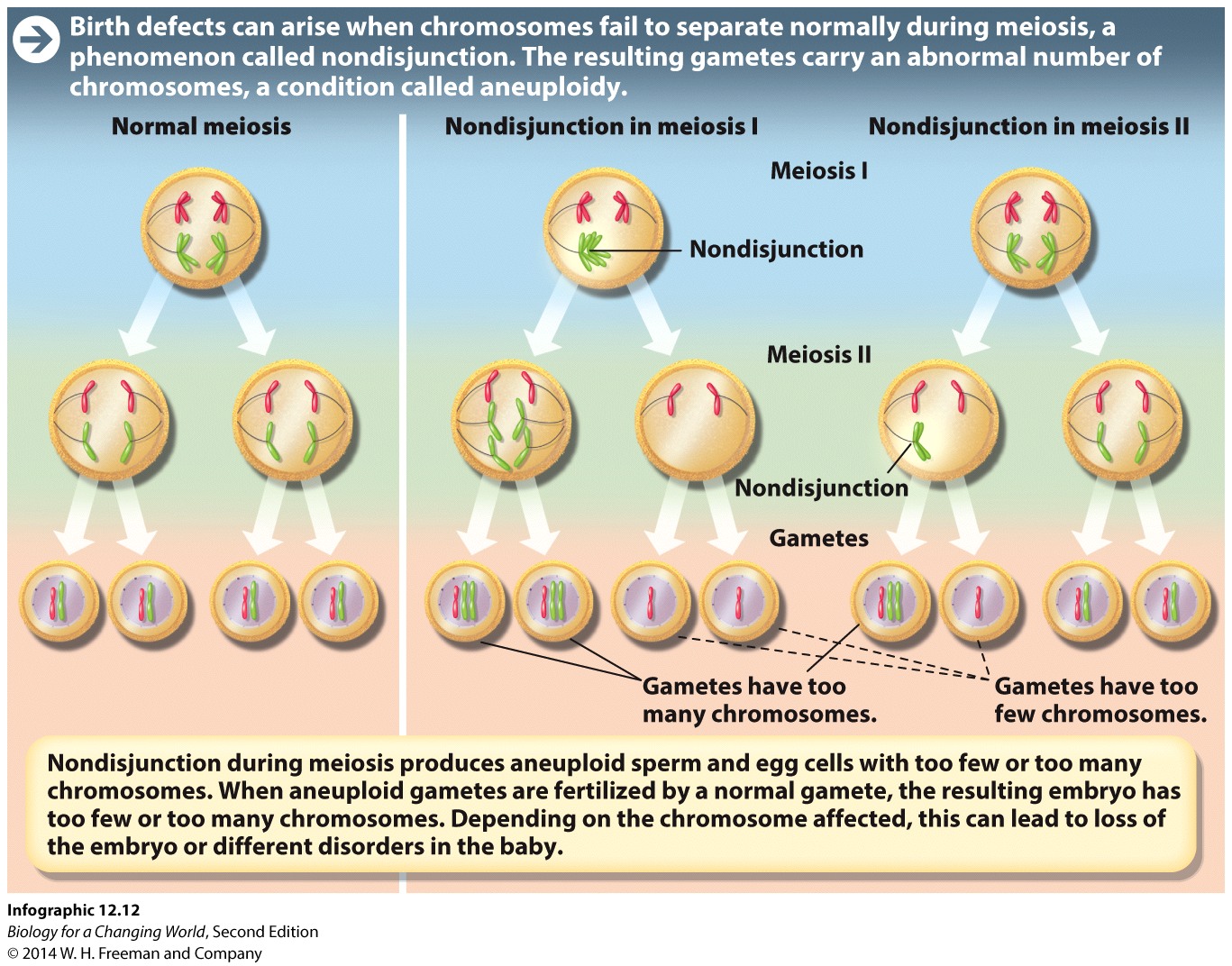
Following the example of Infographic 12.12, trace the path of homologous pairs of chromosomes through meiosis twice. The first time assume nondisjunction occurs during meiosis I, and the second time assume nondisjunction occurs during meiosis II.
How many gametes are affected if the nondisjunction happens during:
meiosis I?
meiosis II?
Predict the chromosomal makeup of a zygote if one of the gametes that produced it was aneuploid.
46.
Combine each of the abnormal gametes you posited in question 1 with another gamete that has the proper number of chromosomes. How many chromosomes are in the resulting zygotes?
Explain how constructing a karyotype of a fetus can determine whether there is any incidence of aneuploidy, specifically how examining a fetal karyotype can determine whether the child will have Down syndrome.
47.
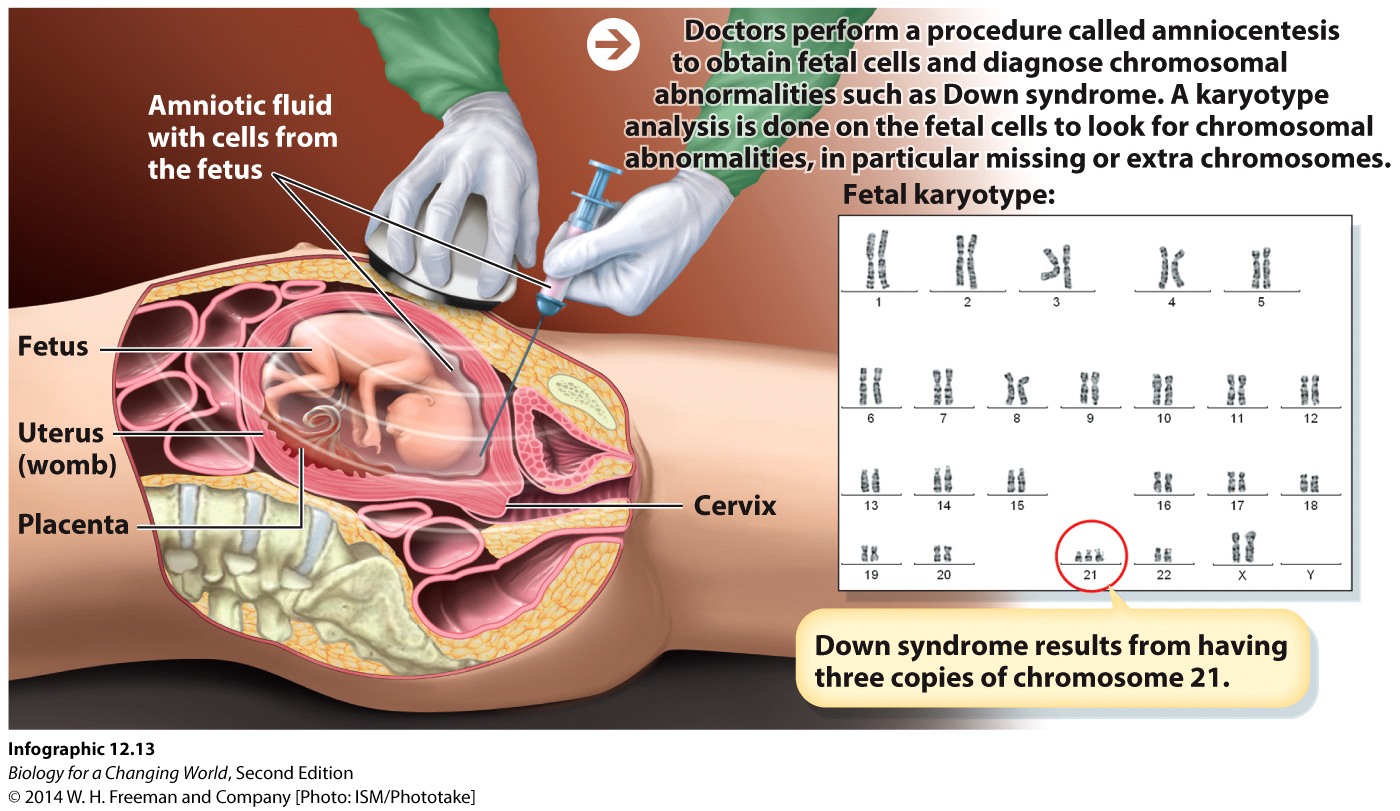
The karyotype above (from Infographic 12.13) is not the way the chromosomes look in an actual cell. It is the result of a researcher painstakingly arranging images of all of the chromosomes obtained from a sampled fetal cell in descending order by size, matching up homologous pairs. This allows for the detection of extra or missing chromosomes.
What is the nature of the aneuploidy associated with Down syndrome?
48.

Although Down syndrome does have some negative effects on those who have it, most of them are able to live happy lives. Examine the karyotype in Infographic 12.13. In most cases, inheriting an extra autosome is fatal to the embryo; propose a reason that this is different for chromosome 21.
Review Questions
49.
Which of the following is typically not the result of a nondisjunction occurring during meiosis?
| A. |
| B. |
| C. |
| D. |
| E. |
50.
In which stage would a nondisjunction event be potentially most detrimental in terms of the number of normal gametes?
| A. |
| B. |
| C. |
| D. |
Activity results are being submitted...